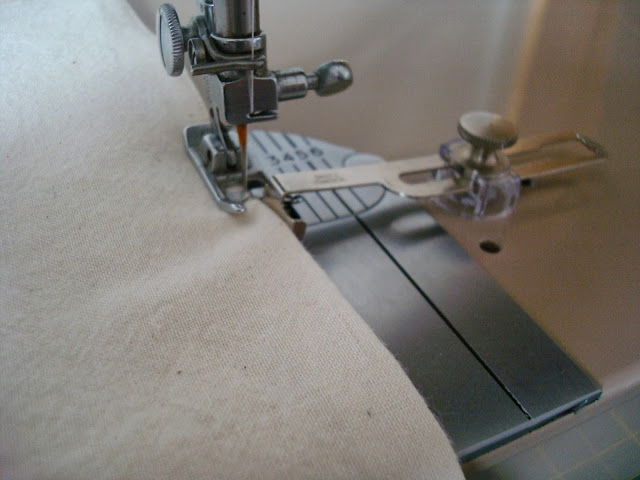I have been reading up about disappearing nine patch quilts here, here and here. I was taken with the setting which imitates sashing and corner stones and decided that might work with the fabrics I have to hand at the moment.
Working from the premise that my individual squares would be cut at five inches based on the common size of commercially available charm packs I began to do some sums.
My quilt will be made up of nine nine patches that's 84 individual squares which would equate to two commercial charm packs at 42 squares each. These will be made up of:
- Nine red for centre of the nine patch blocks - these will become the corner stones
- Thirty-six cream for the middle patches on each side of the blocks - these will become the sashing
- Thirty-six coloured prints for the corner patches of each block - I cut six of each from six different fabrics
The next step was to chain piece nine red squares to nine cream and then set aside nine cream for later.
I am working on the Singer 201K1. I have read that this is the correct designation for a Kilbowie built machine originally fitted to a treadle. I recently shortened the belt on this one. It has made a world of difference. The belt must have stretched making it tricky to get the machine to start and stop. It had a tendency to run backwards at the beginning, run-on when stopping and stalling altogether when crossing thicker seams. I took about 3/8ths of an inch off the length for the time being and now the machine is performing faultlessly.
The thread is Gütermann 100% cotton and the machine is set to 15 stitches per inch. I used my trusty cloth guide to help maintain a scant quarter inch seam. I chain pieced the 18 remaining cream coloured squares to 18 of the mixed colours, three of the six different fabrics. This is the resultant heap of chain piecing.
I snipped the paired squares apart and had a bit of a tidy up. Here are the paired up squares stacked on the treadle table prior to pressing. I production lined my pressing. Pressing all 27 pairs as sewn and then open with all seams away from the cream squares. I tried letting all my pressing cool on the ironing board before moving the units. I'm told it helps the pressed seam allowances stay put.
My next step was to add the remaining nine cream squares to the opposite edge of the red ones.
And then the remaining 18 mixed colours to the other pairs. Selection of the mixed prints at this stage isn't too crucial. The reason for this will become clear next time.
Much more pressing and the nine patches are starting to take shape! From winding the bobbin to taking the last photograph took just under three hours. A nice way to spend a blustery Sunday afternoon.




















